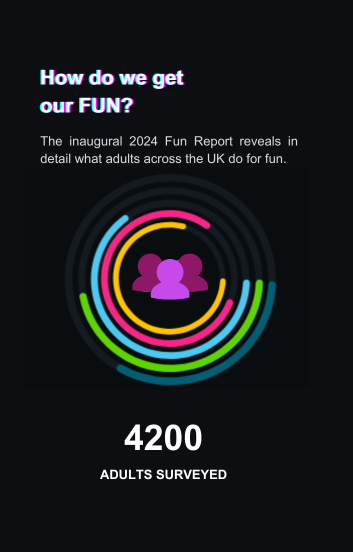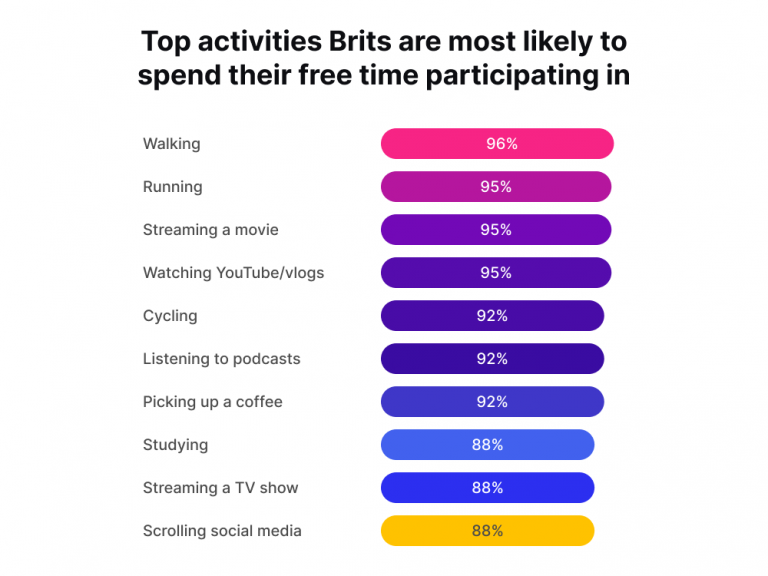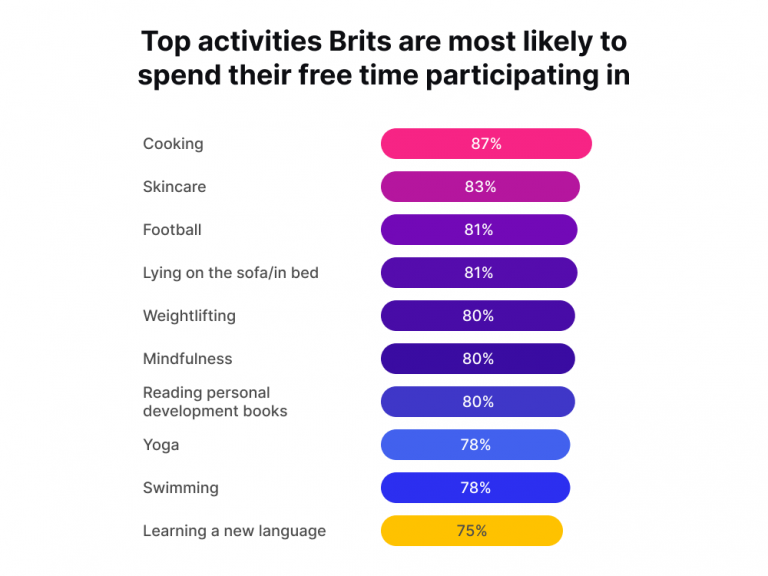FIRST ANNUAL FUN REPORT REVEALS HOW WE GET OUR FUN
Based on robust research from a cross section of UK adults, the inaugural 2024 Fun Report reveals in detail what adults across the UK do for fun, how much time and money we spend on fun, and how it differs between age groups and the sexes.
Skip right to the insights!
Adults Surveyed
Total Data Points
Ways To Have Fun
The Fun Report is a yearly research project commissioned by online gaming brand PlayOJO and conducted by market researcher Global Market Insights.
Featuring analysis of 4200 survey responses across several countries, the report is a serious exploration of the many ways adults seek out fun in their daily lives, from how we choose to spend our leisure time to how social media influences those choices.
Every year, the report will provide an up-to-date snapshot of fun trends in the UK, identify changing preferences, and uncover differences between demographic groups.

Between January and March 2024, market research firm Global Market Insights conducted an online survey of 600 adults in the UK. The representative sample includes an equal proportion of adults from all age groups, starting from 18 to 24, up to 65 and over.
Design
The Fun Report is based on research from a primarily quantitative online survey, designed to gather data on consumer behaviour, preferences, and demographics. employed a straightforward data collection process, inputting survey responses into excel for analysis.
Sampling
Each national Fun Report includes responses from 600 adults, balanced by age and gender, to ensure we achieve a representative sample of the population.
Survey
The Fun Report online survey was live from 29th July to 4th September 2024, allowing sufficient time for diverse participation. The survey included both closed-ended and open-ended questions to gather quantitative data and qualitative insights and was pre-tested for clarity and relevance.
Analysis
Data quality checks were used to identify inconsistencies and incomplete responses, and statistical techniques including segmentation analysis were used to identify trends, correlations, and key insights, and understand differences among demographic groups and countries.
THE ANNUAL FUN REPORT
It’s incredibly easy for everyday routines and responsibilities to sometimes feel like they can suck the fun out of life, but it’s still important to find time to let loose a bit and enjoy yourself. A great way to do this is to take part in things that make you feel good, such as leisure activities. Given our mantra at PlayOJO is ‘feel the fun’, we wanted to take a temperature check of the nation’s attitude towards leisure activities and find out what’s bringing the joy.
We analysed everything from how often and how much people spend on leisure activities, to what brings them the most amount of joy. We’ve even looked at what Brits like to do for fun on a first date.
Having fun and taking part in leisure activities helps to break up the monotonous cycle of everyday life, and also offers numerous benefits like reducing stress, and aiding personal development. Better still, people find that they even make new friends thanks to taking part in the activities that make them happy.
So let’s get stuck into the insights:
Average UK expenditure on leisure activities
Our report shows that UK consumers value their recreational time and are willing to spend on average £98.30, the equivalent to 4% of their monthly salary (post tax) on enhancing their quality of life through activities – monthly salary data taken from Office of National Statistics (ONS).
Nearly a quarter (24%) of Brits admit their mental health would be seriously impacted, and 19% state their physical health would take a hit, if they could no longer take part in their favourite pastimes.
It is clear Brits are serious about leisure, with 15% revealing they always include leisure activity spend within their monthly budgets.
When it comes to how much money the nation is willing to spend on having fun, Brits are spending on average £98.30 per month on leisure activities – the equivalent of an annual spend of £1,180.
Breaking this down by gender however, men are more likely to make a higher investment in leisure activities than women, with nearly a third (30%) spending anywhere between £101 and £200 per month on leisure activities – the equivalent of £1,212 and £2,400 annually. In comparison, nearly a quarter of women (22%) spend between £51 and £100 per month, only equating to £612 and £1,200 annually. This higher investment is likely due to men earning 14% more annually than women as reported by the ONS.
Despite many investing in their leisure activities and even setting money aside each month to experience fun, a staggering 5.5m Brits (8% of the population), admit they don’t spend any money on leisure activities, favouring more cost-effective options – this is likely due to consumers cutting back on leisure activity spend due to increased living costs.
Average monthly leisure spend broken down by age group
Older Millennials and Gen X are more likely to make a higher investment in leisure activities, as data shows those aged between 35 –44 and 45 – 54 spend on average £122.20 and £112.10 respectively per month on activities they define as fun.
On average, 37% of consumers take part in 2 – 3 leisure activities a week, with 12% making sure they do something fun at least once a day such as going for a run or cooking their favourite meal. Daily fun is particularly important for Gen Z, with almost one-third (30%) saying they make sure fun is on the agenda every single day.
Despite fun being an important part of our everyday, 6% of the population admit they often go more than a week without participating in a hobby or social activity, revealing it’s easy for life to get in the way if you aren’t dedicating time to your favourite leisure activities.
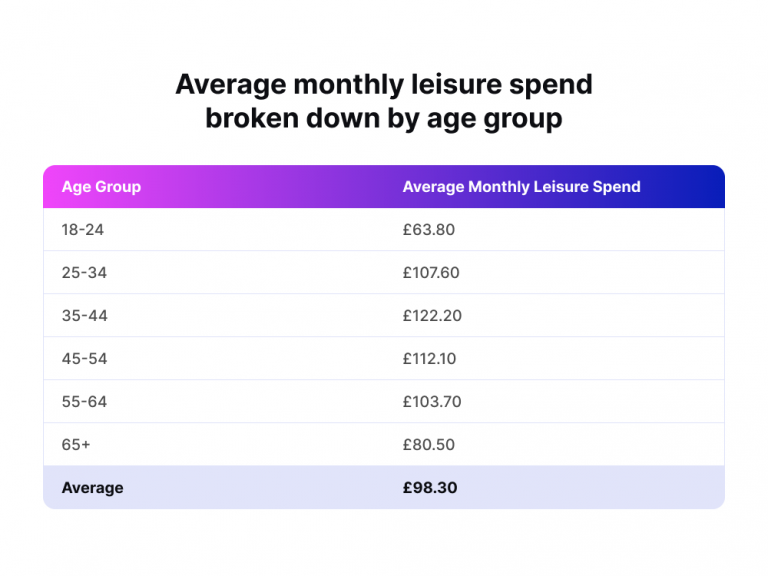
Influencers that play a part in how Brits choose which leisure activities to take part in
When it comes to the factors influencing the nation’s decision on how to spend their free time, personal enjoyment tops the list with nearly a quarter (23%) of Brits agreeing.
The cost of the activity and the time it takes also play a key role, alongside the opportunity to socialise with friends, family or partners – all at 19%. Following closely behind, the location of the activity is also important to 16% of Brits.
Once a taboo topic, mental health is increasingly being spoken about and many people now share the activities which help, or don’t help, their mental health and overall wellbeing. Over one in 10 (11%) pick their choice of leisure activity based on the mental health benefits they will receive and one in 10 (10%) focus on the physical benefit the activity will provide them.
Despite the rise of social media and influencers, only 5% of Brits, the equivalent of 3.4m people, admit to being influenced by social media when it comes to choosing which leisure activities they partake in.
Older millennials (35 – 44) are much more likely to be influenced by what they see on social media, with 7% admitting they choose their leisure activities based on what they view online, such as, viral sensation Pickleball or running thanks to the rise of RunTok – the highest of all age groups. They are followed closely by Gen Z (18 -24) at 6%.
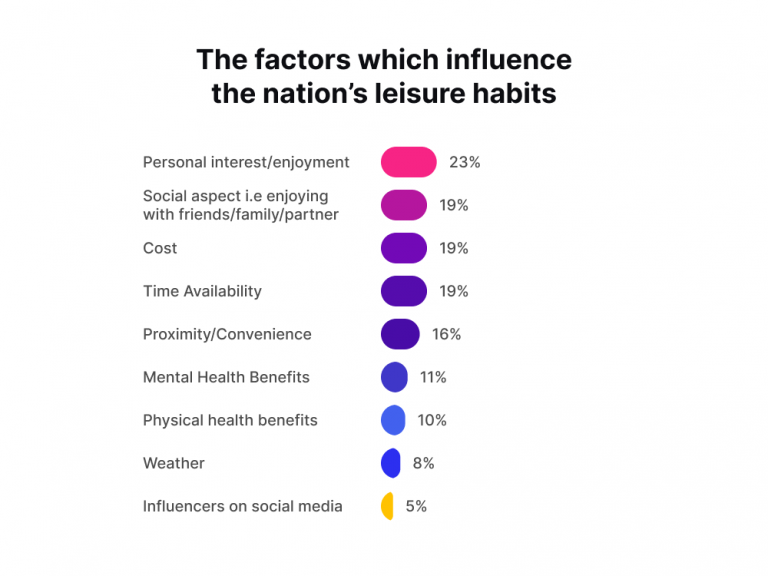
Who do Brits like to have fun with?
When it comes to how Brits like to participate in their favourite leisure activities, most people said they prefer to take part with friends (31%).
With solo travel and solo dining being promoted and talked about across both social media and news platforms, it is no surprise to see that nearly a quarter of Brits (22%) prefer to have fun on their own, however, generationally, opinions differ significantly. When it comes to taking part in leisure activities alone, the older generations feel much more comfortable spending time on their own, with three in 10 people over the age of 65 agreeing, compared to just one in 10 Gen Zs – the lowest of all age groups asked.
Nearly a quarter of Brits also like to have fun with the family members, with women being much more likely to do so at 23% compared to men (17%).
Out of all generations, Millennials are the most likely to want to take part in leisure activities alongside their partner, with 14% agreeing.
One in 10 people don’t mind whether they are with friends, family or alone, as long as they are just having fun. This jumps to nearly a quarter (21%) of Gen Zs.
Nearly one in five (17%) of Brits state most of their friends have been made from participating in leisure activities or hobbies.
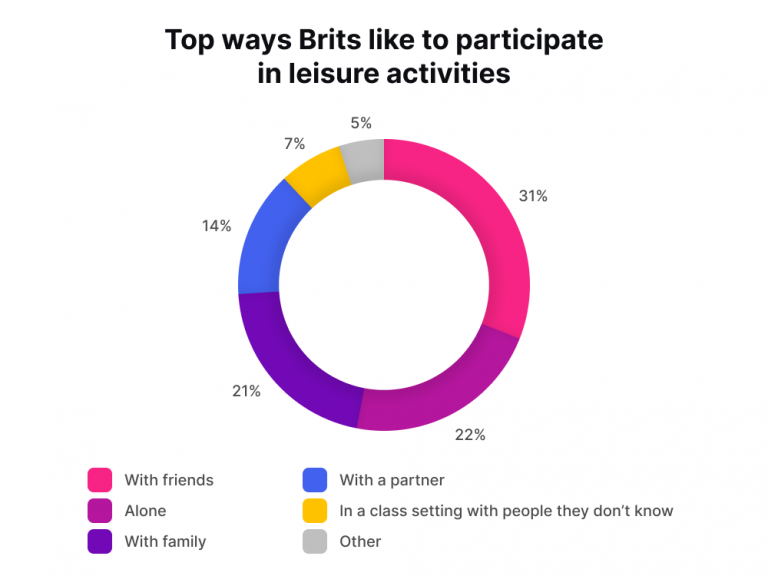
Unwinding after a stressful day
According to Mental Health UK’s Burnout Report, over a third or adults (35%) experience high or extreme levels of stress always or often in the past year and it can be hard to find ways to really relax and unwind after a particularly tough day.
For many, all they want to do when they get home from a hard day in the office is lie down on the sofa and scroll through their phone, with nine in 10 Brits agreeing (90%). Following closely behind is watching their favourite movie or TV show (75%), taking a long bath or shower (70%) and taking part in low intensity activities such as yoga, Pilates and walking (60%).
Nearly half of the population like to take part in online gaming or keep it more old school with board games. Gen Z and Millennials are the age groups most likely to head to an online casino, boot up their Xbox or set up a board game at 35% and 30% respectively.
A quarter (25%) of the nation confess gossiping with their friends or partner at the end of the day is the best way for them to relax and 22% like to get between the sheets with their partner.
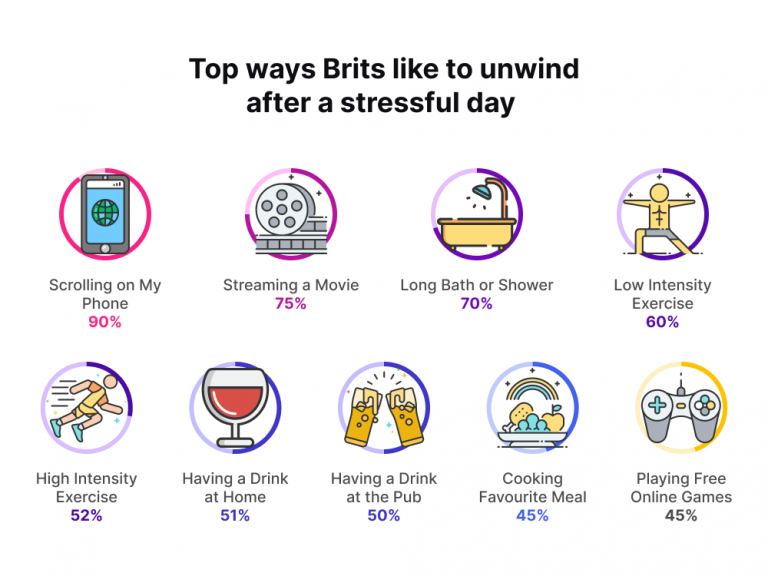
The social media impact
When asked how social media impacts their choice of leisure activities, nearly a quarter (24%) are influenced by what they see online. Women are more likely to try a leisure activity based on what they’ve seen online at 34%, compared to just 29% of men.
8% of the population, rising to 13% of women, admit they are the first to try a trending activity that they’ve seen on social media, such as Reformer Pilates or a game of Padel.
Social media is a haven of inspiration for Brits looking to try new leisure activities and have some fun, and three in five (60%) say they have tried an activity after seeing their friends or favourite influencer talking about it online.
Brits tend to look to Instagram and TikTok for fitness-related activities with a quarter (25%) of people saying they’ve taken up running thanks to RunTok. Yoga (20%) and walking 10,000 steps daily (20%) follow closely behind, followed by CrossFit (10%), bouldering (10%) and TikTok favourite Reformer Pilates (8%).
Once a niche pastime, both Pickleball and Padel are currently having a moment on social media and the data shows a moderate uptake in interest at 5% respectively.
Outside of fitness, Brits are turning to social media for inspiration in the form of trying new recipes (15%), crochet (5%) and pottery painting (5%).
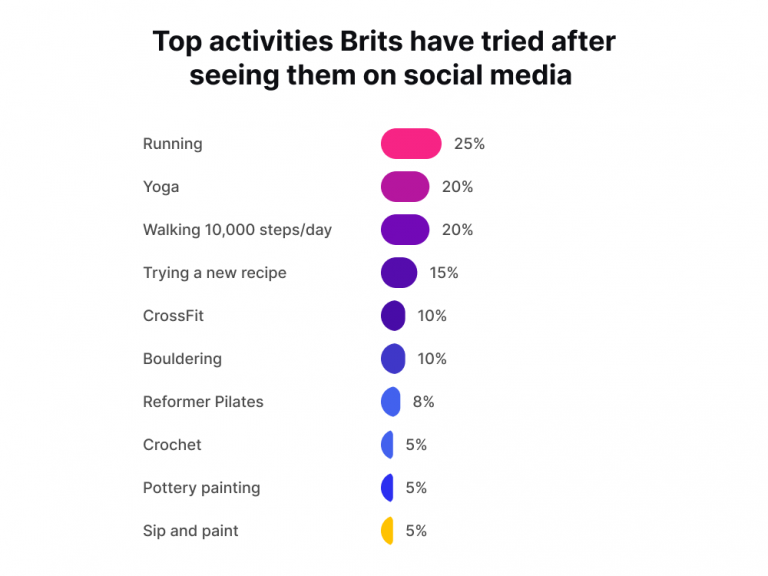
Leisure activities and dating
Typical ‘date’ style activities still reign superior when it comes to the activities Brits would choose for a first date. Over a third (35%) are treating their beau to a dinner date. In typical British fashion, nearly a quarter (23%) are heading to the pub for a drink as they deem it the best way to get to know their date and 17% are sitting in silence at the cinema.
Women are much more likely to favour an intimate dinner, at 45% compared to just 35% of men, whereas men prefer to get to know their date over a drink at the pub at 30% and 20% respectively.
The tide is turning though, as Brits choose unconventional date activities as a way of getting to know their date. 7% are keen to play a racket sport against their date, such as Pickleball or Padel, 6% are keen to go bouldering or rock climbing, 5% would pick up a microphone and sing karaoke and 3% are booking adrenaline sports such as sky diving or bungee jumping as their first date of choice – phew!
When it comes to the activities Brits would attend if they were trying to meet a romantic partner, a supper club tops the list at 18%, followed closely by a pub quiz (17%) and a book club (14%).
Gen Zs favour physical activity when trying to meet a new romantic partner with 12% attending a run club or a yoga/Pilates class with the intention of bagging a date, followed by one in 10 who would head to their local gym class to meet their future partner.
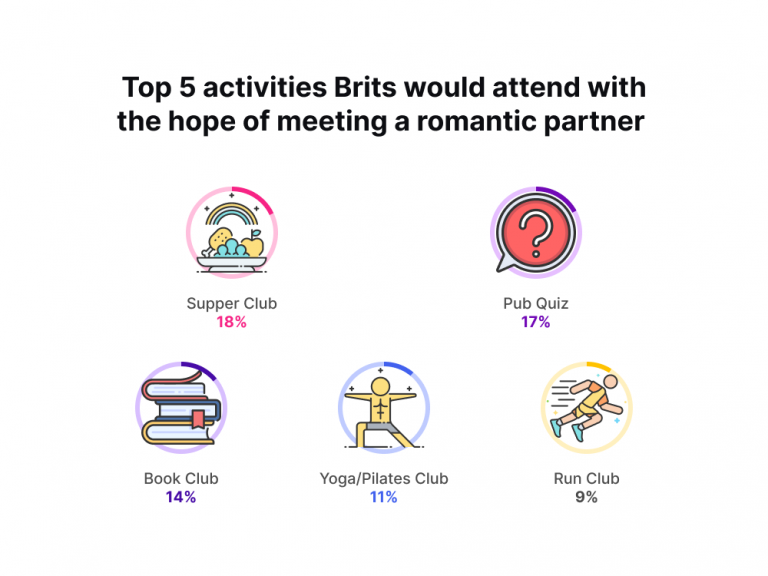
Side hustle culture
The rise of side hustles as a way of making additional income has inspired Brits to turn their hobbies into a money maker. Nearly a quarter (21%) of the nation have made money from a leisure activity, with Millennials being the age group most likely to earn money from a hobby.
Of those who have made money from a leisure activity, over a quarter (26%) said it made them feel proud that they could make money from their hobbies, and 20% continued to say it makes them enjoy the activity much more knowing they are getting a monetary bonus.
However, 13% say they now enjoy their leisure activities much less as it applies too much pressure.
Some Brits are relying on the income they make from their hobbies, with 6% agreeing – rising to 10% of women. It’s the younger generations who rely more on the income from their side hustle at 8% and 7% respectively.
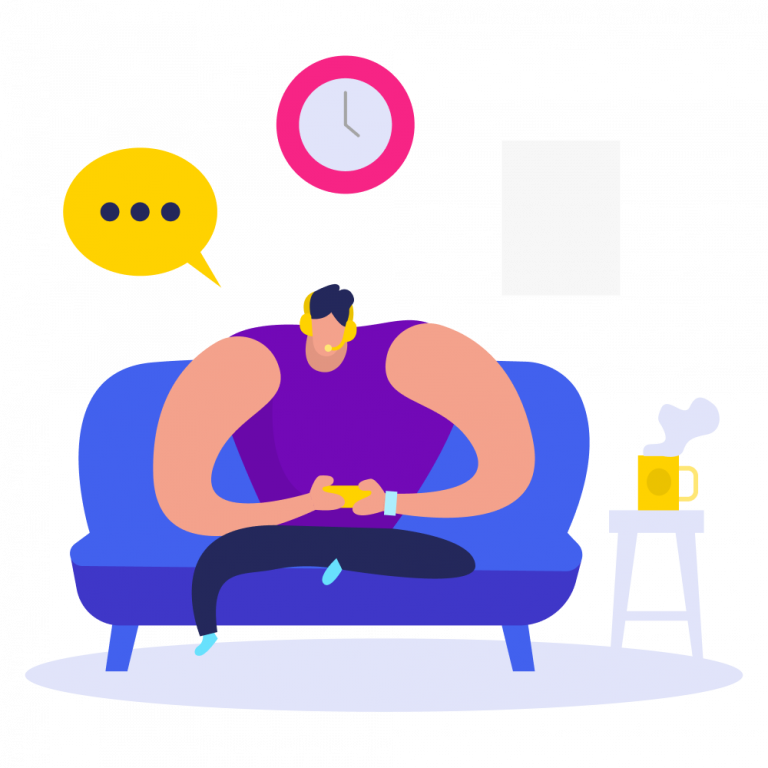
Conclusion
Having fun and taking part in leisure activities helps to break up the monotonous cycle of everyday life, but it also has a huge impact on our social, mental and physical wellbeing.
Whether it’s going for a run around your local park, trying the latest trend you’ve seen on social media with a friend or playing your favourite online game, it’s important to carve out time in your weekly schedule to have a bit of fun.


